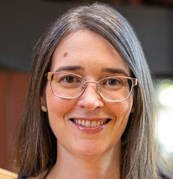Cycling & Micromobility Planning
There have never been as many travel choices for people who want to cycle and scoot, but are they accessible to all? This session looks at evolving cycling and micromobility trends, programs and projects.
Session Outline
- Session Chair - Tim Sullivan, TfNSW
- Dr Alexa Delbosc, Zi Goh & Masha Naseri, Monash University - Do new bike lanes increase cycling during a pandemic? A case study from Melbourne
- Dr Alexa Delbosc & Tiange (Charles) Chen, Monash University - Widening access to shared micromobility: Lime Access in Australasia
- Evi Janse de Jonge & Clare Huggins, Stantec - Adaptive active transport planning for communities
Dr Alexa Delbosc, Monash University - Do new bike lanes increase cycling during a pandemic? A case study from Melbourne
Dr Alexa Delbosc
Senior Lecturer | Monash University
Dr. Alexa Delbosc is a Senior Lecturer at the Monash Institute of Transport Studies in the Department of Civil Engineering. She conducts researcher in travel behaviour and teaches Traffic Engineering and Management with an emphasis on managing the system for the needs of all road users.
Co-Author(s):
Zi Goh | Student - Monash University
Zi is a final year Civil Engineering student at Monash University. His passion for engineering lies in identifying and exploring problems due to global phenomena.
Mahsa Naseri | PhD Student - Monash University
Mahsa is a Ph.D. student in transportation engineering at Monash University. Her research focus is on the interaction of the built environment and leisure active travel during COVID-19 restrictions.
Do new bike lanes increase cycling during a pandemic? A case study from Melbourne.
COVID-19 has dramatically changed how people travel in cities. Many cities saw significant increases in cycling rates during the pandemic, and in response some cities implemented temporary or permanent improvements in safe cycling infrastructure.
In Melbourne, overall cycling rates declined significantly during COVID-19, likely because of lockdown-enforced restrictions on travel more generally. In 2020 and 2021, the City of Melbourne fast-tracked a range of cycling infrastructure upgrades in an effort to attract more workers back into the city using this sustainable transport mode.
This study examines whether trends in weekday cycling near the city are beginning to recover from the impacts of the pandemic, using bicycle count data from 15 automatic counters within 5km of the city centre. In addition, this paper quantifies the impact of COVID-era infrastructure upgrades. Negative binomial regression modelling found that weekday bicycle counts were significantly dampened during lockdown and remain 39% below pre-COVID levels.
More importantly, even when controlling for lockdown stage and seasonality, counters near upgraded infrastructure had 22% higher average daily counts compared to non-upgraded sites. This increase is significant given that overall demand for travel into the city has decreased significantly. These findings are particularly relevant for cities that are grappling with whether to continue with temporary cycling infrastructure upgrades and cities that are struggling to encourage workers back into cities without relying on car travel.
This study suggests that providing upgrades to cycling networks is an effective tool in this effort.
Dr Alexa Delbosc, Monash University - Widening access to shared micromobility: Lime Access in Australasia
Dr Alexa Delbosc
Senior Lecturer | Monash University
Dr. Alexa Delbosc is a Senior Lecturer at the Monash Institute of Transport Studies in the Department of Civil Engineering. She conducts researcher in travel behaviour and teaches Traffic Engineering and Management with an emphasis on managing the system for the needs of all road users.
Co-Author(s):
Tiange (Charles) Chen | Student - Monash University
Charles is a final-year student studying Civil Engineering at Monash University.
Widening access to shared micromobility: Lime Access in Australasia
Shared bicycle and scooter programs are expanding around Australia and New Zealand. Some have argued that they can expand mobility options for low-income populations who cannot afford a car. Yet costs can be a barrier for low-income people to access these programs. Lime Access is a program that provides low-cost access to Lime Bike and Lime Scooter, attempting to overcome some of these barriers to participation. This program has only recently been introduced in Australia and New Zealand, so we know very little about who uses Lime Access in Australasia.
In this study, we use a survey of over 400 Lime customers in Australia and New Zealand to learn how low-income customers use micromobility services and how their use differs from other customers. Preliminary findings suggest Lime Access customers are more likely to use micromobility for utilitarian trips (e.g. work or shopping) and less likely to use it for recreation. They are also more likely to want a wider network of scooters or bikes. Findings from this study will suggest implications for the expansion of similar systems throughout Australia.
Evi Janse de Jonge, Stantec - Adaptive active transport planning for communities
Evi Janse de Jonge
Consultant | Stantec
Evi is an urban planner who grew up, studied and worked in The Netherlands. She joined Stantec in 2021 in the transport planning and design team and has mainly worked on active travel projects.
Co-Author(s):
Clare Huggins | Stantec
Clare is a strategic planner with experience in transport, planning and sociology. She has specific experience in transport planning, policy and strategy development, monitoring and evaluation, engagement and capacity building. Through her deep listening and facilitation skills she has formed meaningful relationships to achieve evidence-based and sustainable project outcomes. Clare has delivered projects in varied contexts and excels and creates narratives that align with client and stakeholder expectations.
Our neighbourhoods are made up of streets which should be safe and vibrant. These streets are not only designed by engineers, planners, or designers, they are created by the people who use them. Stantec will reflect on three projects where it has used adaptive transport planning and put the community at the centre of the project. The projects are all active travel projects with the public sector. Stantec will share the lessons learnt from working with and for communities on active travel projects.
Planners, designers and engineers have to design for communities with often limited time and knowledge of the project area. Active travel projects are not always immediately embraced by the community. During the presentation we will share some of the challenges we face when planning and designing active infrastructure. We will explain our take on adaptive planning and use three active travel project examples to explain how we can work with and for communities to achieve better street design outcomes.
For the first project, Stantec worked closely with Hobsons Bay City Council to realise their vision for the Greenline Cycling Corridor, which forms part of the city’s strategic cycling network. Based in initial community engagement, a suite of designs were developed based on these findings. The community was then consulted on several design options. The final design aims to address all community concerns such as loss of car parking while balancing increased safety for cyclists.
The second project example is the pop-up bike lane project that is ongoing in different Councils in Melbourne. Stantec will talk about the benefits and challenges of pop-up bicycle infrastructure and reflect on lessons learnt during the project.
The last project example uses the Healthy Streets Tool where locals were invited to assess their streets through a different lens. Stantec empowered the community through training and workshops and in turn, the community educated Stantec through their lived experiences. An easy-to-understand document listed questions related to the ten Healthy Streets indicators and volunteers had the option to take photos and make notes of things they noticed on their streets.
The final section of the presentation will discuss the key lessons learnt during the three active travel projects; using the right language and framing, use of renders and how to communicate visually, design for practice and timing of communication.








